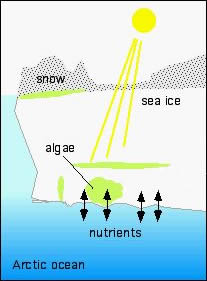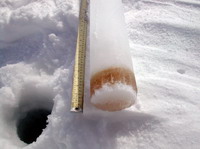What do we know about organisms that thrive in Arctic sea ice?
Sea ice: a refuge for life in polar seas?
Christopher Krembs
Jody Deming
University of Washington
Arctic sea ice covers significant portions of the northern hemisphere's ocean, forming and persisting at temperatures below the freezing point of seawater. That freezing point is generally around -1.9°C when the salinity is 33 parts per thousand; however, the freezing point changes with the concentration of salt in the seawater. As ice crystals grow in the water during the autumn season, small ice platelets begin to accumulate at the ocean surface, to inter-link, and to form a porous structure of ice crystals filled with liquid, which is referred to as brine.
The flourishing life within the briny habitat of sea ice. The ice-specific ecosystem includes bacteria, viruses, unicellular algae, diatom chains, worms and crustaceans. Click on the image to see a magnified view of the brine channels containing these organisms.
Life within the briny habitat of sea ice is intricately linked to physical processes. Temperature controls every physical and chemical aspect of ice, including availability of light. The most notable effect of decreasing temperature, as winter progresses and the ice solidifies, is the reduction of pore space within the ice and the concurrent increase in the salinity of the brine. Sea ice, especially during the sunlit seasons, serves as habitat for an ice-specific food web (sympagic foodweb) [1] that includes bacteria, viruses, unicellular algae, which often form chains and filaments, and invertebrates sufficiently small to traverse the brine network. The brine network is comprised of passages in the ice, with diameters ranging from micrometers to several centimeters when the temperature remains above -5°C.
During the colder winter months, however, strong gradients of temperature persist in the ice, spanning from -2°C at the bottom of the ice in contact with seawater to -35°C at its wind-chilled surface. Here, connectivity of pore space is at a minimum, brine salinities reach 250 parts per thousand [2] and salts begin to precipitate as opaque minerals. Since the organisms have the same temperature as the ice, their survival depends on their ability to prevent the growth of ice crystals in their bodies. Many organisms accumulate large deposits of organic molecules and fatlike material as a strategy to survive the harsh winter. Studying the capability of organisms to survive such extreme environments is an active research field of astrobiology, an interdisciplinary science concerned in part with the effects of extraterrestrial environments on living organisms. Wintertime sea ice, as well as other forms of deeply frozen ice on Earth, can be used as an analogue for possible extraterrestrial habitats in the frozen subsurface realms of such solar bodies such as Europa, Ganymede, Mars and Titan.
Sea ice is critical for polar marine ecosystems in at least two important ways: (1) it provides a habitat for photosynthetic algae and nursery ground for invertebrates and fish during times when the water column does not support phytoplankton growth; and (2) as the ice melts, releasing organisms into the surface water [3], a shallow mixed layer forms which fosters large ice-edge blooms important to the overall productivity of polar seas.
In winter sea ice constitutes a thermal barrier against the cold winter atmosphere with the result that the interface between the ice and the seawater remains near the temperature of seawater. During spring, when light becomes available for photosynthesis, and throughout the summer, a large biomass of unicellular photosynthetic ice algae develops within the lowermost sections of the ice. These algae occasionally form long filaments that can extend several meters into the water column (Melosira arctica). Ice algae are a very important part of the marine food web, contributing on average 57% to the total Arctic marine primary production [4]. As grazing pressure is small within the brine channels due to limited access [5] significant quantities of organic material can accumulate within the ice crystals. Excretions of metabolic products and debris from dying cells contribute to an increasing pool of organic material. As the ice melts in summer, this material releases into the water column, where it contributes to the vertical flux of material that fuels both pelagic and benthic food webs. Some components of this organic pool, however, have been shown to affect the properties of the ice itself long before it melts [6] Live sea-ice organisms are thus understood to sculpt and improve the habitability of their icy homes (Sculpted brine habitat), a discovery very new to our understanding of biological-physical interactions at high latitudes. The sculpted lower portions of the ice flushed by seawater are particularly critical to the polar marine ecosystem. Algae anchor and flourish within this nutrient-rich skeletal layer of the ice. The organisms that eat algae, called zooplankton grazers (such as Gammerus wilkitzkii), seek not only food in this algal-rich ice but also protection from their own predators. Arctic cod (Breogadus saida), an important food source for many marine mammals and birds (Arctic marine food web), use the same habitat as nursery grounds.
Larger warm-blooded animals such as birds, seals, whales and polar bears use the ice for migration routes, hunting grounds, rookeries and protection for raising their young. Because sea ice is a diverse and constantly changing habitat, appearing in such varied forms as thin or "nilas" pancake ice, ridged first-year and multi-year ice several meters thick, and pack ice circulating in the central Arctic, animals have had to become very good navigators, using homing cues that as yet are not well understood.
At the peak of ice-algal production in spring, the solid ice cover transforms into pack ice with individual floes that transport organisms, sediment (see ice core photograph) and, unfortunately, man-made pollutants over thousands of kilometers before they melt and discharge their contents into the water. Scientists aim to understand how sea ice, with its physics, extent and drift patterns, affects various marine populations and the overall food web in polar waters (the cryopelagic food web), which has provided sustenance for generations of native Inuit peoples. As ice extent and thickness have changed significantly over recent decades [7], current research efforts are dedicated to understanding the consequences of both past and predicted patterns of sea ice on polar marine ecosystems. The International Polar Year of 2007-2008 constitutes an intensive international effort in both the Arctic and Antarctic realms to address these (and many more) questions.
 |
| (Sculpted brine habitat) Microscopic photographs depicting brine pores of laboratory-grown, organic-free sea ice (A), ice grown in the presence of algal-derived organic materials that sculpt the brine pores (B), and the naturally sculpted habitat of sea ice off the coast of Alaska with organic material stained blue and an algal filament extending from one of the pores near the bottom of the ice (C). [8] |
References
[1] Horner R. A., S. F. Ackley, G. S. Dieckmann, B. Gulliksen, T. Hoshiai, L. Legendre, I. A. Melnikov, W. S. Reeburgh, M. Spindler, and C. W. Sullivan (1992). Ecology of sea ice biota. 1. Habitat, terminology, and methodology. Polar Biol. 12, 417-427. Return to article here.
[2] Cox G. F. N. and W. F. Weeks (1983). Equation for determining the gas and brine volumes in sea-ice samples. J. Glaciol. 29, 306-316. Return to article here.
[3] Michel C., T. C. Nielsen, C. Nozais, and M. Gosselin (2002). Significance of sedimentation and grazing by ice micro- and meiofauna for carbon cycling in annual sea ice (northern Baffin Bay). Aqua. Microb. Ecol., 30, 57-68. Return to article here.
[4] Gosselin M., M. Levasseur,
P. A. Wheeler, R. A. Horner, and B. C. Booth (1997). New
measurements of phytoplankton and ice algal production in
the Arctic Ocean.
Deep-Sea Res. II, 44, 1623-1644. Return to
article here.
[5] Krembs C., R. Gradinger, and M. Spindler (2000). Implications of brine channel geometry and surface area for the interaction of sympagic organisms in Arctic sea ice. J. Exp. Mar. Ecol., 243, 55-80. Return to article here.
[6] Raymond J. A. and C. A. Knight (2003). Ice binding, recrystallization inhibition, and cryoprotective properties of ice-active substances associated with Antarctic sea ice diatoms. Cryobiology 46, 174-181. Return to article here.
[7] Near-realtime Arctic Sea ice information from the NOAA Arctic Change website
[8] Krembs C., H. Eicken, and J.W. Deming 2011. Exopolymer alteration of physical properties of sea ice and implications for ice habitability and biogeochemistry in a warmer Arctic PNAS, 108, (9), 3653-3658.
Sea Ice in the Bering Sea and the North Pacific Ocean
3/2/2011







